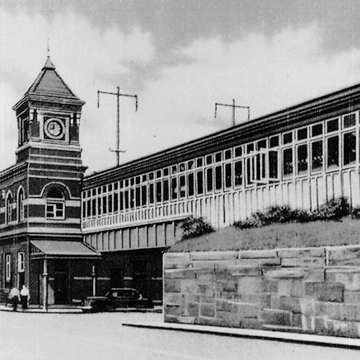You are here
Wilmington Station (Pennsylvania Railroad Passenger Station)
The Italian Renaissance–style station concluded the career of legendary Philadelphia architect Frank Furness. With an expensive project to elevate the Pennsylvania Railroad tracks on a viaduct through Wilmington (WL10) came the need for a new station on the site of the old one (of the 1870s). Furness faced a challenge—the trains would run right across the top of the first floor, and an ancient riverbed underlay the foundations (for this reason, two hidden rows of brick arches rest on piles). The station is faced with Kittanning (Pennsylvania) brick and robust red terra-cotta—Furness trademarks. A square clocktower rises above one corner. High-quality materials were employed: copper and tile for the roofs, white oak interior paneling, tile floors, and marble in the bathrooms. By 1925, 185 passenger trains stopped at the bustling station daily. Today, it is the eleventh busiest in the United States and forms part of the largest surviving complex of Furness railroad buildings anywhere. Renovations in the 1980s saw the introduction of tile mosaics by nationally known artist Joyce Kozloff, part of a series of public art projects she was then undertaking at train stations. Behind the station stands Furness's Pennsylvania Building (1905–1906), which served as the office for the Pennsylvania Railroad in Wilmington. It was redeveloped by a Philadelphia firm for ING Direct bank (2003, IEI Group), with the unfortunate removal of an ornate staircase spared in a previous (1980s) gutting of the building.
Writing Credits
If SAH Archipedia has been useful to you, please consider supporting it.
SAH Archipedia tells the story of the United States through its buildings, landscapes, and cities. This freely available resource empowers the public with authoritative knowledge that deepens their understanding and appreciation of the built environment. But the Society of Architectural Historians, which created SAH Archipedia with University of Virginia Press, needs your support to maintain the high-caliber research, writing, photography, cartography, editing, design, and programming that make SAH Archipedia a trusted online resource available to all who value the history of place, heritage tourism, and learning.


